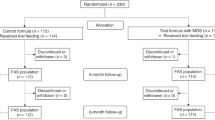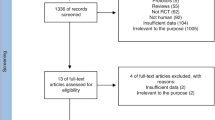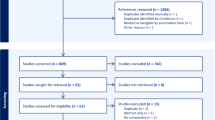Abstract
Objectives:
The aim of this study was to evaluate the efficacy on crying episodes owing to infantile colic of a new infant formula containing partially hydrolysed whey proteins, prebiotic oligosaccharides (OS), with a high β-palmitic acid content.
Design:
Prospective randomized controlled study.
Setting:
Italy.
Subjects:
Two hundred and sixty-seven formula-fed infants, aged less than 4 months, with infantile colic, were randomized to receive either the new infant formula (study treatment (ST)) or a standard formula and simethicone (6 mg/kg twice a day) (control treatment (CT)). A questionnaire was given to parents to evaluate for 14 days the daily number of colic episodes and crying time.
Results:
Out of the 199 infants who completed the study, 96 were treated with the new formula and 103 were not treated. Infants receiving the new formula had a significant decrease in colic episodes after 1 week (2.47±1.94 at day 7 vs 5.99±1.84 at the study entry) compared to infants receiving the CT (3.72±1.98 at day 7 vs 5.41±1.88 at the study entry) (P<0.0001). Also at day 14, the crying episodes were significantly different between the two groups of infants (1.76±1.60 in ST vs 3.32±2.06 in CT) (P<0.0001).
Conclusions:
The use of a partially hydrolysed formula supplemented with fructo- and galacto-OS induces a reduction of crying episodes in infants with colic after 7 and 14 days when compared with a standard formula and simethicone.
Sponsorship:
The study was supported by funds from Numico, Italy.
This is a preview of subscription content, access via your institution
Access options
Subscribe to this journal
Receive 12 print issues and online access
$259.00 per year
only $21.58 per issue
Buy this article
- Purchase on Springer Link
- Instant access to full article PDF
Prices may be subject to local taxes which are calculated during checkout

Similar content being viewed by others
References
Agostoni C, Axelsson I, Goulet O, Koletzko B, Michaelsen KF, Puntis JW et al. (2004). Prebiotic oligosaccharides in dietetic product for infants: a commentary by the ESPGHAN committee on nutrition. J Pediatr Gastroenterol Nutr 39, 465–473.
Bakker-Zierikzee AM, Alles MS, Knol J, Kok FJ, Tolboom JJM, Bindels JG (2005). Effects of infant formula containing a mixture of galacto-and fructo-oligosaccharides or viable Bifidobacterium animalis on the intestinal microflora during the first 4 months of life. Br J Nutr 94, 783–790.
Boehm G, Fanaro S, Jelinek J, Stahl B, Marini A (2003). Prebiotic concept for infant nutrition. Acta Paediatr 91, 64–67.
Boehm G, Jelinek J, Stahl B, van Laere K, Knol J, Fanaro S et al. (2004). Prebiotics in infant formulas. J Clin Gastroenterol 38, S76–S79.
Canivet C, Hagander B, Jakobsson I, Lanke J (1996). Infantile colic: less common than previously estimated? Acta Paediatr 85, 454–458.
Fanaro S, Chierici R, Guerrini P, Vigi V (2003). Intestinal microflora in early infancy: composition and development. Acta Paediatr 91, 48–55.
Garrison MM, Christakis DA (2000). Early childhood: colic, child development, and poisoning prevention. A systematic review of treatments for infantile colic. Pediatrics 106, 184–190.
Haller D, Jobin C (2004). Interaction between intestinal luminal bacteria and host: can a healthy relationship turn sour? J Pediatr Gastroenterol Nutr 38, 123–136.
Hill JD, Hosking CS (2000). Infantile colic and food hypersensitivity. J Pediatr Gastroenterol Nutr 30, 67–76.
Iacono C, Carroccio A, Montalto G, Cavataio F, Bragion E, Lorello D et al. (1991). Severe infantile colic and food intolerance: a long-term prospective study. J Pediatr Gastroenterol Nutr 12, 332–335.
Jakobsson I, Lothe L, Ley D, Borschel MW (2000). Effectiveness of casein hydrolysate feedings in infants with colic. Acta Paediatr 89, 18–21.
Kalliomäki M, Lappala P, Korvenranta H, Kero P, Isolauri E (2001). Extent of fussing and colic type crying preceding atopic disease. Arch Dis Child 84, 349–350.
Knol J, Steenbakkers GMA, van der Linde EGM (2002). Bifidobacterial species that are present in breast-fed infants are stimulated by changing to a formula containing prebiotics. J Pediatr Gastroenterol Nutr 34, 477.
Knol J, Scholtens P, Kafka C, Steenbakkers JGS, Helm K, Klarczyk M et al. (2005). Colon microflora in infants fed formula with galacto- and fructo-oligosaccharides: more like breast-fed infants. J Pediatr Gastroenterol Nutr 40, 36–42.
Lehtonen L, Korvenranta H, Eerola E (1994). Intestinal microflora in colicky and non-colicky infants: bacterial cultures and gas liquid chromatography. J Pediatr Gastroenterol Nutr 19, 310–314.
Lindberg T (1999). Infantile colic and small intestinal function: a nutritional problem? Acta Paediatr 88, 58–60.
Lucas A, St James-Roberts I (1998). Crying, fussing and colic behaviour in breast- and bottle-fed infants. Early Hum Dev 53, 9–18.
Lucas A, Quinlan P, Abrams S, Ryan S, Meah S, Lucas PJ (1997). Randomised controlled trial of a synthetic triglyceride milk formula for preterm infants. Arch Dis Child Fetal Neonatal Ed 77, F178–F184.
Lucassen PLB, Assendelft WJJ, Gubbels JW, van Eijk JTM, van Geldrop WJ, Knuistingh Neven A (1998). Effectiveness of treatments for infantile colic: systematic review. BMJ 316, 1563–1569.
Lucassen PLBJ, Assendelft WJJ, Gubbels JW, van Eijk JTM, Douwes AC (2000). Infantile colic:crying time reduction with a whey hydrolysate: a double-blind, radomized, placebo-controlled trial. Pediatrics 106, 1349–1354.
Mihatsch WA, Franz AR, Kuhnt B, Hogel J, Pohlandt F (2005). Hydrolysis of casein accelerates gastrointestinal transit via reduction of opioid receptor agonists released from casein in rats. Biol Neonate 87, 160–163.
Miller-Loncar C, Bigsby R, High P, Wallac M, Lester B (2004). Infant colic and feeding difficulties. Arch Dis Child 89, 908–912.
Moro G, Minoli I, Mosca M, Fanaro S, Jelinek J, Stahl B et al. (2002). Dosage-related bifidogenic effects of galacto- and fructooligosaccharides in formula-fed term infants. J Pediatr Gastroenterol Nutr 34, 291–295.
Newburg DS (2000). Oligosaccharides in human milk and bacterial colonisation. J Pediatr Gastroenterol Nutr 30, S8–S17.
Newburg DS (2000). Oligosaccharides in human milk and bacterial colonisation. J Pediatr Gastroenterol Nutr 30, S8–S17.
Rigo J, Pieltain C, Studzinski F, Knol J, Bindels JG (2001). Clinical evaluation in term infants of a new formula based on prebiotics, β-palmitate and hydrolysed proteins. J Pediatr Gastroenterol Nutr 32, 402.
Rinne MM, Gueimonde M, Kalliomaki M, Hoppu U, Salminen SJ, Isolauri E (2005). Similar bifidogenic effects of prebiotic-supplemented partially hydrolyzed infant formula and breastfeeding on infant gut microbiota. FEMS Immunol Med Microbiol 43, 59–65.
Savino F, Cresi F, Maccario S, Cavallo F, Dalmasso P, Fanaro S et al. (2003). ‘Minor’ feeding problems during the first months of life: effect of a partially hydrolysed milk formula containing fructo- and galacto-oligosaccharides. Acta Paediatr 91, 86–90.
Savino F, Cresi F, Pautasso S, Palumeri E, Tullio V, Roana J et al. (2004). Intestinal microflora in breastfed colicky and non-colicky infants. Acta Paediatr 93, 825–829.
Savino F, Bailo E, Oggero R, Tullio V, Roana J, Carlone N et al. (2005). Bacterial counts of intestinal Lactobacillus species in infants with colic. Pediatr Allergy Immunol 16, 72–75.
Schmelzle H, Wirth S, Skopnik H, Radke M, Knol J, Bockler HM et al. (2003). Randomized double-blind study of the nutritional efficacy and bifidogenicity of a new infant formula containing partially hydrolyzed protein, a high β-palmitic acid level, and nondigestible oligosaccharides. J Pediatr Gastroenterol Nutr 36, 343–351.
Sicherer SH (2003). Clinical aspects of gastrointestinal food allergy in childhood. Pediatrics 111, 1609–1616.
Van Loo JAE. (2004). Prebiotics promote good health. J Clin Gastroenterol 38, S70–S75.
Van Loo JAE (2004). Prebiotics promote good health. J Clin Gastroenterol 38, S70–S75.
Walker WA, Duffy LC (1998). Diet and bacterial colonization: role of probiotics and prebiotics. J Nutr Biochem 9, 668–675.
Wessel MA, Cobb JC, Jackson EB, Harris GS, Detwiler AC (1954). Paroxismal fussing in infancy, sometimes called ‘colic’. Pediatrics 14, 421–434.
Acknowledgements
We acknowledge the work was partially funded by a grant from Numico, Italy.
Author information
Authors and Affiliations
Corresponding author
Additional information
Guarantor: F Savino.
Contributors: FS directed and supervised the overall programme, and was responsible for study design. EP and EC were the principal investigators and were responsible for implementing the programme, data collection and editing of the paper. FC was responsible for data analysis and drafting of the paper. PD and FC contributed to the programme design and statistical analysis. RO was responsible for medical aspects of the programme, and contributed to the writing and editing of the paper.
Rights and permissions
About this article
Cite this article
Savino, F., Palumeri, E., Castagno, E. et al. Reduction of crying episodes owing to infantile colic: a randomized controlled study on the efficacy of a new infant formula. Eur J Clin Nutr 60, 1304–1310 (2006). https://doi.org/10.1038/sj.ejcn.1602457
Received:
Revised:
Accepted:
Published:
Issue Date:
DOI: https://doi.org/10.1038/sj.ejcn.1602457
Keywords
This article is cited by
-
Verwendung von diätetischen Lebensmitteln für besondere medizinische Zwecke („bilanzierte Diäten“) für Säuglinge, Aktualisierung 2022
Monatsschrift Kinderheilkunde (2022)
-
Infant feeding practice and gastrointestinal tolerance: a real-world, multi-country, cross-sectional observational study
BMC Pediatrics (2022)
-
The Link Between Infantile Colic and Migraine
Current Pain and Headache Reports (2016)
-
Beta-palmitate – a natural component of human milk in supplemental milk formulas
Nutrition Journal (2015)
-
Reduced crying in term infants fed high beta-palmitate formula: a double-blind randomized clinical trial
BMC Pediatrics (2014)



